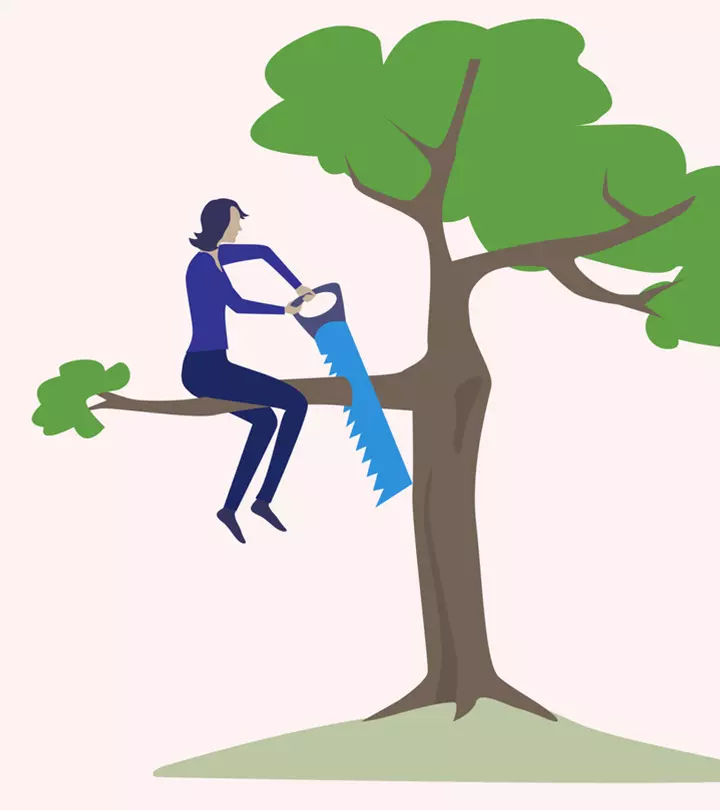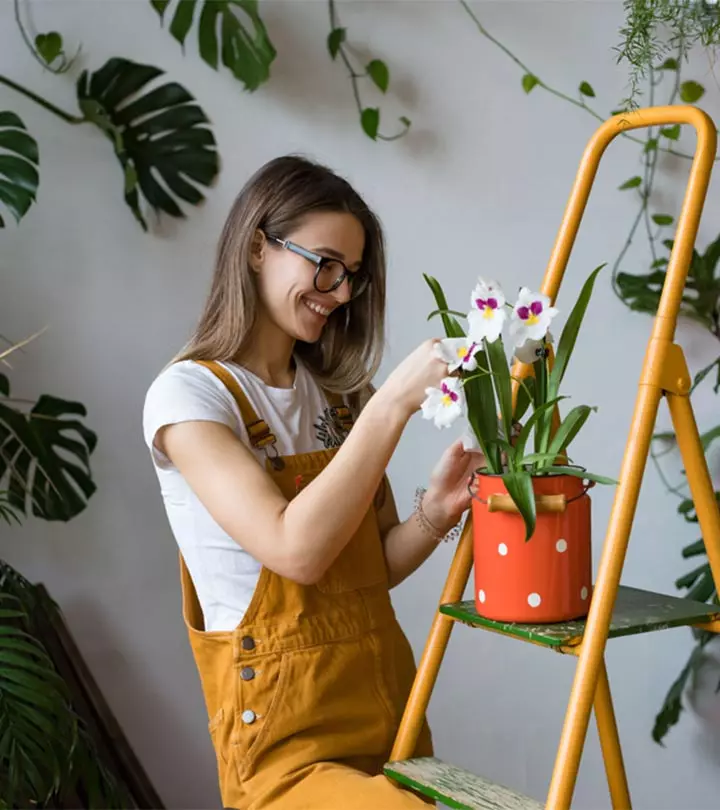25 Proven Ways To Communicate With An Avoidant Partner
Dating with this attachment style can seem difficult till you learn how to say what needs to be said.

Image: Shutterstock
In This Article
Understanding Avoidant Attachment Styles
Avoidant attachment styles often develop in one’s childhood due to inconsistent caregiving. Individuals with avoidant issues may struggle with intimacy, preferring emotional distance and independence (1). There are two main avoidant attachment styles, dismissive and fearful.
People with dismissive avoidant issues tend to avoid deep connections. They find it hard to express themselves and may even be unsure of how to react when others express their emotions. Those with fearful attachment issues may want love but fear vulnerability and rejection, and even get anxious when it comes to commitment. So they may try to get closer to you but push you away when you try to get closer to them.
It is important to understand this attachment style for two reasons. The person with the issues learns how to manage them and grow, while the people around them learn how to support them in their journey. This helps foster healthy relationships and addresses the underlying fears of intimacy and closeness.
Now that you know the common ways avoidant attachment style occurs, let us go ahead and read some proven strategies that can help you communicate effectively with an avoidant partner.
Key Takeaways
- Allow your partner the space to help them heal and resolve their inner conflict.
- Offer words of appreciation to your partner.
- Clearly state your own needs within the relationship.
- Communicate a sense of safety to your partner by using active listening and accepting them rather than trying to fix them.
25 Proven Strategies To Communicate With An Avoidant Partner
People with an avoidant attachment style are independent and tend to avoid emotional intimacy. So, before we discuss the strategies to communicate with them, it’s crucial to understand the attachment theory. This concept in psychology developed by John Bowlby and Mary Ainsworth focuses on the relationship we have as infants with our primary caregiver, and how responsive they were to our needs. While we may have been helpless and non-verbal, our brain still stores the information regarding whether or not we can expect to get our basic needs met, which includes food, shelter, cleanliness, love, and emotional connection.
According to this framework, we all develop a pattern of behavior in our future relationships. The basic forms of attachment include secure, anxious, and avoidant. If you have a partner with an avoidant attachment style, here is how you can effectively communicate with them:
1. Do Not Chase An Avoidant Partner

Attachment styles in adults reflect their childhood conditioning and dynamics with their primary caregivers. It can be due to the deprived care and tenderness they needed as children. Inconsistent care or neglect by a primary caregiver sends the brain a huge, blaring signal that they must be self-reliant, and others cannot be trusted to meet their needs or even stick around.
Adopting a deflective attachment style protected them from disappointment or getting their feelings hurt. However, this can be a tricky thing to deal with while dating someone with avoidant traits.
If you have the knack for pursuing people who require a lot of space, you will likely chase them away even faster or turn and retaliate. Instead, allow them the space when an avoidant partner withdraws into their reserved mode. While it may hurt to let them go momentarily, but running after them will prolong the chase before they come back to you.
2. Don’t Take Their Distance Personally
Avoidant partners distance themselves as a self-soothing mechanism. They have a deep-seated fear of losing themselves. Avoidant partners adopt the belief that the only relationship that feels safe is the one they have with themselves since everybody leaves and they need to rely on themselves. Allowing such partners space to work through their feelings while letting them know you support them is likely the response that allows for a healthy relationship dynamic. If an avoidant partner is too critical of you, it is important to draw a boundary and simply state, “I will not be talked to like that.” The origin of this criticism is likely related to the person’s own self-criticism and is not your responsibility to hold.
Remember that your partner’s behavior is not personal and is a reflection of their inner conflict. If an avoidant partner is too critical of you, it’s not your obligation to absorb any of it. Also, remember that your partner can be self-critical too.
3. Ask For What You Need
When we don’t get what we want in a relationship, it is better to ask rather than nag about it openly. The chances are that your avoidant partner may not have thought of things from your perspective. Rather than being passive-aggressive and making them guess what you need, let them know.
Most partners become responsive when someone they care about speaks of their needs. So you can try using ‘I feel’ statements as an attempt to express your feelings without assigning blame on the other person. This gesture will make it easier for avoidant partners to participate in the conversation. You can take inspiration from the cues mentioned below to help you express your needs without sounding demanding.
- “It would make me feel really good if you did this.”
- “I would really like you to…”
- “I feel loved and cherished when you….”
- “Can we spend more quality time together? I need some extra reassurance today.”
4. Reinforce Positive Behavior
Let them know your approval and appreciation when they do things you like. Talk about the things you value the most in your relationship and things that are working well. This can help you create balance in an avoidant partner’s tendency to hyper-fixate only on the negative. Since they are constantly looking for reasons to run, hide, or shut down, acceptance, positive affirmations, and reassurance can help break that pattern and make them feel secure.
5. Extend Your Understanding

Qualities that are often short in supply are active listening and patience. Be open to understanding your partner’s feelings and problems when they choose to express themselves. Rather than trying to fix the problem, hear them out. Be there for them or provide compassionate advice.
6. Being Dependable
Avoidant partners expect the other party to drop and be disappointed. That makes it more crucial for you to do as you say and not make promises you cannot honor. If something comes up and you must break a promise, be sure to communicate that thoroughly with your partner so they are not left thinking that the change is not an indication of your commitment to the relationship.
7. Respect The Differences
Understand that your partner may be a step behind, slower than your ideal pace. Communication avoidance does not necessarily imply your partner is not interested in being with you.
8. Cultivate Your Interests
Nobody can complete all your needs. The key to drawing your avoidant partner out of their shell is to be independent and have your own life that you enjoy. Watching you being self-reliant will make them want to share your enriched life. Understanding how to communicate with a spouse may help in developing a deeper relationship, even with an avoidant partner.
9. Recognize That You Both May Have Unrealistic Fantasies
Your avoidant partner may have a dream just like yours, which can be unrealistic. Look at each other as humans where it is okay to have unique flaws rather than being swept up in a fairytale.
10. Express Intense Emotions With Care

You need to express your feelings and wants clearly while learning how to communicate your needs to your partner. Emotions expressed intensely often overwhelm avoidant people who cannot hear the message because they freeze or shut down. You are more likely to be heard if you communicate your feelings honestly and openly but in a moderate tone.
Also, it’s crucial to avoid the blame game any time when your emotions run high. A tried and true formula for effectively expressing your feelings in a relationship is to use “I feel” statements. Notice the different feelings you get when you hear, “I feel scared when you pull back and I don’t know what you’re thinking” versus “You always do this! Go ahead, run away again – you never stay to talk things out.” As you can probably tell, both these responses are expressing hurt and fear, but they would elicit very different responses from your partner.
11. Give Them Space
You may want to open the emotional floodgates when you feel your partner is inching closer. Instead, live in the moment and enjoy your partner’s efforts to get close without pushing them further than they are ready to go.
12. Avoid Rigid Roles
Defining roles in a relationship can shake your partner’s sense of security in the initial stages. So, instead of focusing on the gender role aspects, try to be more flexible with the roles as per your dynamics, considering each of your strengths, weaknesses, likes, and dislikes.
13. Work On Your Abandonment Issues
An avoidant partner can infuriatingly trigger your abandonment issues, which can be very unhealthy in the long run. It can lead to anxiety, panic, or depression. Therefore, work through these issues in self-healing ways by listening to your partner, validating their feelings, and creating a neutral space. These are some of the essential communication skills you need for a successful relationship. Moreover, you can also seek professional therapy, if you want.
14. Do Not Try To Fix Or Rescue Your Partner
Trying to change or fix your partner’s basic attachment style is being ‘Bob the Builder’ and will only lead to more fruitless disappointment. If you need to parent your partner, you are ignoring your needs, which is not a healthy trait in a relationship.
Remember that you entered a relationship to build a partnership with this person. Iif you have to parent them more than partner with them, this is a sign of unhealthy dynamics that need to be addressed. A couples counselor can help if it feels like this issue cannot be resolved between the two of you.
15. Be Honest About Your Needs
We often settle for less because we love someone, but love alone is not enough to sustain a healthy relationship. If your core needs and desires are left unmet, love can turn into resentment. So, be honest with yourself about this, and if you think that your partner cannot meet these needs, it is wise to think about going your own way.
16. Set Healthy Boundaries

Healthy boundaries are the key to a healthy relationship. Set examples of how you expect to be respected, what is acceptable, and what you won’t tolerate. Love does mean that you should accept dysfunctional patterns.
Defining relationship deal breakers is also crucial. When you are in the midst of an emotional push and pull, it can be difficult to remember to take a step back and look at what is really happening in the relationship. Identifying and communicating deal breakers in the relationship gives your partner clear guideposts of where your most firm boundaries lie.
 Quick Tip
Quick Tip17. Understand Your Partner’s Limitations
Knowing how to communicate with an avoidant partner may need you to give yourself some personal time and distance. They may never change. Nobody is perfect, and some quirks, if not toxic to your mental and emotional health, are fine living with.
18. Aim At Growth
Every relationship is unique as the human fingerprint, so there are no hard and fast milestones for growth. If you are an anxious person, the journey of healing with an avoidant partner might need the aid of a relationship counselor or a couple’s therapy group. If you love each other, seeking help from professionals to make it last is a good step forward.
19. Understand Your Attachment Style
Although avoidant partners may look cold and unfeeling, they can be equally anxious. If you want to understand the communication secrets for a secure relationship, understanding your attachment style will help a lot.
20. Stay Consistent and Provide A Safe Environment

Your avoidant partner as a child was likely discouraged or didn’t have their emotions validated by a parent. These children may have felt they were disappointed by their primary caregivers, and hence, the feeling of emotional safety is fundamental to them. Try to be your partner’s safe haven. This doesn’t mean that you try to parent them – it means being there for them when they need you most.
21. Remember That You’re An Individual
It is tempting to get so involved in a relationship that you lose your sense of self. However, this can be detrimental and self-sabotaging. Instead, retain your identity by building yourself, achieving things for yourself, and taking up equal space to secure your self-esteem as an individual.
22. Do Not Give Ultimatums
Avoidant partner’s distancing tactics often have deep-seated roots. Some may have grown up being overwhelmed by parental pressure, while others may have been conditioned that they couldn’t say ‘no’ to their parents or authority figures. Giving an ultimatum instead of practicing nonviolent communication with empathy and respect will make you appear rude because avoidant attachments shut down instantly at the first sign of their emotional safety net shaking.
 Quick Tip
Quick Tip23. Don’t Beat Around The Bush
Talking in riddles can lead to anxiety or frustration. An avoidant partner will react by deflecting such conversations if they feel uncomfortable. The key to communicating with avoidant partners effectively is to speak to them regarding important matters or emotional subjects without beating around the bush. Dropping hints to our partner means you are, to a certain extent, expecting them to read your mind. Be direct and specific when communicating a need or desire.
24. Quit Emotional Games
Vulnerability is essential to a relationship, but being vulnerable at times can be scary, especially when you feel like you are dating someone who acts detached. During such situations, your defense mechanism may kick in and push you to act the same way. Unfortunately, this may ruin your peace of mind more than helping you communicate better with your avoidant partner since both of you are walking on eggshells.
Often, calling out what you think is happening in the relationship can help to clear up misunderstandings. Identifying the issue and saying it out loud can open the line of communication. Your partner may not have a helpful response, but they will have a clear picture of what’s going on.
Show up maturely in the face of such situations and say things for what they are. You don’t have to pretend not to be affected by their facade and mirror them. Sometimes, what’s needed is a dose of honesty where your earnestness can trigger theirs.
It’s important to note that some (not all) avoidant partners can turn to manipulation even if they don’t know they are doing it. Remember that any partner threatening suicide, if you leave, is an act of emotional abuse. If you are concerned your partner may act on this threat, call emergency services for help.
25. Know When To Call It Quits

It is admirable for someone to actively communicate their needs and desire for depth in a relationship. However, if your partner takes no note of it, refuses to work on themself, or can’t provide you the level of security you need, maybe it’s time to call it quits.
An avoidant in love might show subtle signs to let you know they have feelings for you. Read on to learn how avoidants show love.
How Do Avoidants Show Love?
While the avoidant may also be in love with you, it might not be quite clear at times. Their emotionally distant and erratic behavior can send mixed signals. Here are a few signs that avoidants show when they are in love:
- Share their vulnerability and deep emotions with you.
- Introduce you to their close family members and friends.
- Engage in non-verbal romantic gestures, such as holding hands in public.
- Respect your personal space and encourage you to spend time with yourself.
- Make conscious efforts to talk and stay connected with you.
- Listen to your concerns about the relationship and take steps to nullify your doubts.
- Make the first move in the relationship to be physically intimate.
It is understandable to be torn when a person is inherently good but has an avoidant attachment, but you are dating them as a whole and not their potential. If their avoidance and emotional detachment hurts and they can’t work on it, maybe they have not reached a stage where they desire true healing. Therefore, it is better to take a break for the sake of your emotional and mental health.
Infographic: 5 Tips To Build A Strong Relationship With An Avoidant Partner
Are you struggling to communicate with your avoidant partner? Don’t worry, you are not alone. Understanding a partner’s needs and limitations is crucial to building a healthy relationship. To improve your communication and build a stronger relationship with your partner, check out the 5 essential tips in the infographic below!

Illustration: StyleCraze Design Team
Avoidant partners are individuals who may not feel comfortable sharing intimate details about themselves with their partners, which can lead to anger and frustration in a relationship. If you want to know how to communicate with an avoidant partner, you can follow simple and effective strategies. It is important to openly tell them what you want from the relationship and understand their limitations. However, if your partner fails to compromise and work on themselves and cannot provide you with a secure relationship, it may be time to take a break from them and work on yourself.
Frequently Asked Questions
What do avoidant partners need?
They need trust (the feeling of you being there for them). They also need to develop trust within themselves that they are worthy of love and partnership. So try to spend some quality time together as this period helps them build some positive vibes.
How do you tell if an avoidant loves you?
If they make a true effort to connect with you, offer some romantic gestures, or give you some personal space, all these signs will tell you that your avoidant partner loves you.
How do you make an avoidant partner miss you?
It is not recommended to follow practices that may make your avoidant partner miss you on purpose as it indicates playing mind games with your partner. This type of behavior is immature and passive, negating all your efforts to maintain a healthy relationship.
How do I get avoidants to commit?
It’s better not to force an avoidant partner to commit. Instead, you have to give them time and space to open up and see whether they are ready to commit and take things further. Showing genuine interest and constant support may help them develop the trust in you and make them commit. It’s better to let them decide.
Should I stop expressing my feelings to avoid making avoidants uncomfortable?
No, your feelings matter too. However, you can work around how you deliver your feelings. Instead of overwhelming them, try sharing in a calm, non-pressuring way. Focus on “I” statements rather than making them feel guilty. For example, instead of saying “you never inform me where you are going and never call back, it is so irresponsible,” you can say, “I worry about you, so I would really appreciate it if I get a simple text from you with basic details like where are you going and when will you be back.”
Is it better to just give up on avoidants and find someone more emotionally available?
That depends on you. If their avoidance makes you feel unloved and exhausted, you might not be a good fit as a couple. However, if they express willingness to work on it, the relationship can grow stronger. It is on you to assess their response, figure out if you can hold on, and then decide if you find the relationship sustainable.
How do I get avoidants to commit?
It’s better not to force an avoidant partner to commit. Instead, you have to give them time and space to open up and see whether they are ready to commit and take things further. Showing genuine interest and constant support may help them develop the trust in you and make them commit. It’s better to let them decide.
What triggers avoidant attachment?
A parent or caregiver being consistently unavailable emotionally or physically to serve the needs of a child can trigger avoidant attachment.
How do you make an avoidant feel safe?
Listen to them, pay attention to their needs, try to accept them for who they are, be emotionally available, and if they need some space, give them. These actions help make an avoidant feel safe.
Why do avoidants push you away?
Many people with avoidant attachment styles have a hard time trusting others, and a difficult time understanding that they deserve love and companionship. Remember that if their caregiver was not able to attend to their needs, it indicates that they cannot count on others, but also that they weren’t valuable to be loved and cared for. These beliefs were planted in infancy, and they can’t be changed in a matter of months or weeks. However, with the help of a therapist and a desire for change, someone who is avoidant can start to shift these beliefs for themselves.
Learn how to improve communication with an avoidant partner with the help of the video below. Discover 12 simple steps to help you better understand and connect with your partner.
References
Articles on StyleCraze are backed by verified information from peer-reviewed and academic research papers, reputed organizations, research institutions, and medical associations to ensure accuracy and relevance. Read our editorial policy to learn more.
- Attachment in Adulthood
https://www.sciencedirect.com/topics/psychology/attachment-avoidance
Read full bio of Katharyn Engers
Read full bio of Sneha Tete
Read full bio of Shatabdi Bhattacharya
Read full bio of Reshma Latif



























Community Experiences
Join the conversation and become a part of our empowering community! Share your stories, experiences, and insights to connect with other beauty, lifestyle, and health enthusiasts.